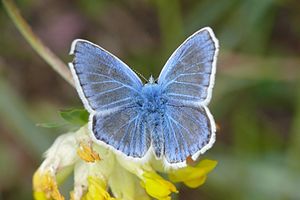Blue velvet
| Blue velvet | ||||||||||||
|---|---|---|---|---|---|---|---|---|---|---|---|---|

Blue clover ( Polyommatus dorylas ) |
||||||||||||
| Systematics | ||||||||||||
|
||||||||||||
| Scientific name | ||||||||||||
| Polyommatus dorylas | ||||||||||||
| ( Denis & Schiffermüller , 1775) |
The Wundklee's Blue ( Polyommatus dorylas ) is a butterfly ( butterfly ) from the family of Gossamer (Lycaenidae). It is sometimes referred to as blue sweet clover, which is completely misleading.
features
The blue sorrel is quite a large blue type, which, like many other blue types, is characterized by a pronounced sexual dichroism . The upper sides of the wings are characterized by a wide, whitish to cream colored hem. The wing tops of the males are bright blue, those of the females are brown. On the underside of the hind wing there is a light, wedge-shaped area that is not shown. Together with the arrangement of the spots, it serves as a distinguishing feature.
Similar species
- Polyommatus atlantica Elwes, 1905. Algeria and Morocco .
- Himmelblauer Bläuling ( Polyommatus bellargus ) Rottemburg, 1775. The males are also intensely blue on the upper side, but the pale wing edge is piebald.
Flight time
The species flies at lower altitudes in two generations from May to June and from late July to August. Only one generation is formed at higher altitudes; it flies from the end of June to August.
habitat
The habitat of the bluish clover includes grassy, flower-rich areas between bushes in lower elevations. In the high mountains, on the other hand, there are protected depressions and open grass slopes (lean meadows in areas rich in lime).
Way of life
After mating, the females lay eggs on the leaves of kidney vetch ( Anthyllis vulneraria ab). The species is myrmekophil and lives symbiotically with different ant species such as Lasius alienus , Myrmica scabrinodis and Formica cinera . The small caterpillars overwinter in the ground under the forage plants.
distribution
The blue sorrel is common in northern and central Spain ( Montes Universales , Sierra de la Demanda , in the Cantabrian Mountains and the Pyrenees ). Furthermore, from the northwestern Pyrenees to southern Sweden (including Öland and Gotland ) and Lithuania . It can also be found in Eastern Europe , the Balkans and Greece . The species is probably extinct in Latvia . The reports from Corfu , Tinos and Syra are probably confused with names. In the vertical distribution, the species reaches heights of up to 2300 meters, Ebert gives maximum heights for Baden-Württemberg between 700 and 800 meters.
- Red List FRG: 2
- Baden-Württemberg Red List: 1
swell
Individual evidence
- ↑ Tom Tolman, Richard Lewington: The butterflies of Europe and Northwest Africa . Franckh-Kosmos, Stuttgart 1998, ISBN 3-440-07573-7 , p. 121 .
- ↑ Butterfly. 2. Special part: Satyridae, Libytheidae, Lycaenidae, Hesperiidae . In: Günter Ebert, Erwin Rennwald (eds.): The butterflies of Baden-Württemberg . 1st edition. tape 2 . Ulmer, Stuttgart (Hohenheim) 1991, ISBN 3-8001-3459-4 , pp. 371 .
- ↑ Federal Agency for Nature Conservation (Ed.): Red List of Endangered Animals in Germany . Landwirtschaftsverlag, Münster 1998, ISBN 3-89624-110-9 .
literature
- Hans-Josef Weidemann: Butterflies: observe, determine . Naturbuch-Verlag, Augsburg 1995, ISBN 3-89440-115-X .
- Manfred Koch : We determine butterflies. Volume 1: Butterfly. 4th enlarged edition. Neumann, Radebeul / Berlin 1966, DNB 457244224 .
Web links
- www.schmetterling-raupe.de
- Lepiforum e. V.
- Polyommatus (Polyommatus) dorylas in Fauna Europaea. Retrieved March 3, 2011
